Enhancing Road Freight Price Forecasting Using Gradient Boosting Ensemble Supervised Machine Learning Algorithm
Abstract
1. Introduction
1.1. Background and Motivation
1.2. Research Objectives and Significance
1.3. Research Gap
- Distance-related features, such as total route length and national breakdowns.
- Cargo-related features, including weight, volume, and temperature requirements.
- Temporal features, such as loading and delivery dates, weekdays, months, and time windows.
- Operational features, including the number of loading and unloading points, vehicle and body types, and service-specific conditions.
- Geographical and route characteristics, covering origin–destination relations, route types, and country-specific statistics.
- Derived and aggregate indicators, such as price per kilometre, mean route rates, and seasonally averaged values.
1.4. Manuscript Structure
2. Materials and Methods
2.1. Data
2.2. Software
2.3. Research Workflow
2.4. Missing Values
2.5. Feature Engineering
2.5.1. Feature Extraction
2.5.2. Feature Transformation and Imputation
2.5.3. Aggregation
2.6. Modelling
2.7. Evolutionary Feature Selection
| Algorithm 1. Evolutionary feature selection |
| Input: Dataset D = (X, y); population size N; generations G; crossover prob. pc; mutation prob. pm; tournament size k; uniform gene prob. pu; regularization α Output: Best feature subset S* 1: Initialize population P with N binary masks over features of X 2: For each individual z ∈ P do 3: Decode subset S(z) ← indices where mask bit = 1 4: Train model on features S(z) using the chosen CV protocol 5: Compute fitness F(z) ← MAPE(S(z)) + α · |S(z)| 6: end for 7: for t = 1 to G do 8: Parents ← TournamentSelection(P, size = k) 9: Offspring ← ∅ 10: while |Offspring| < N do 11: Select (p1, p2) from Parents 12: With prob. pc: (c1, c2) ← UniformCrossover(p1, p2, gene prob. = pu) 13: Else: (c1, c2) ← (p1, p2) 14: Mutate c1, c2 by bit-flip with prob. pm per gene 15: Repair c1, c2 if needed (e.g., ensure at least one feature selected) 16: Evaluate F(c1), F(c2) as in lines 3–5 17: Add c1, c2 to Offspring 18: end while 19: P ← Elitism(P ∪ Offspring, keep N by best fitness) 20: end for 21: Return S* ← S(argmin_z F(z)) |
2.8. Evolutionary Hyperparameter Optimization
| Algorithm 2. Evolutionary hyperparameter optimization |
| Input: Feature subset S; search space H; population size N; generations G; crossover probability pc; mutation probability pm; tournament size k; per-gene mutation probability pu Output: Best hyperparameter vector θ* 1: Initialize population P with N random hyperparameter vectors sampled from H 2: For each individual θ ∈ P: 3: Train model with parameters θ on S using CV respecting temporal order 4: Compute penalized validation loss F(θ) = E_cv(θ, S) + λ · C(θ) 5: End for 6: For t = 1 to G do: 7: Parents ← TournamentSelection(P, size = k) 8: Offspring ← ∅ 9: While |Offspring| < N do: 10: Select (θ1, θ2) from Parents 11: With prob. pc: perform crossover to get (φ1, φ2), else copy parents 12: Mutate φ1, φ2 per gene with prob. pu (Gaussian for real-valued, step for integer, resample for categorical) 13: Repair infeasible parameters (respect constraints in H) 14: Evaluate F(φ1), F(φ2) as in lines 3–4 15: Add φ1, φ2 to Offspring 16: End while 17: P ← Elitism(P ∪ Offspring, keep N best by F) 18: End for 19: Return θ* ← argmin_θ F(θ) |
- is the cross-validated error;
- is a capacity/complexity proxy;
- balances accuracy and parsimony.
2.9. Ablation Study
3. Results
3.1. EDA
3.2. Evolutionary Feature Selection with Nested Cross-Validation
3.3. Results of Evolutionary Hyperparameter Optimization
3.4. Comparison with a Distance-Only Baseline
4. Discussion
5. Conclusions
Author Contributions
Funding
Data Availability Statement
Acknowledgments
Conflicts of Interest
References
- Mrabti, N.; Hamani, N.; Delahoche, L. The Pooling of Sustainable Freight Transport. J. Oper. Res. Soc. 2021, 72, 2180–2195. [Google Scholar] [CrossRef]
- Meidutė-Kavaliauskienė, I.; Stanujkic, D.; Vasiliauskas, A.V.; Vasilienė-Vasiliauskienė, V. Significance of Criteria and Resulting Significance of Factors Affecting Quality of Services Provided by Lithuanian Road Freight Carriers. Procedia Eng. 2017, 187, 513–519. [Google Scholar] [CrossRef]
- Kummer, S.; Dieplinger, M.; Fürst, E. Flagging out in Road Freight Transport: A Strategy to Reduce Corporate Costs in a Competitive Environment. J. Transp. Geogr. 2014, 36, 141–150. [Google Scholar] [CrossRef]
- Patel, Z.; Ganu, M.; Kharosekar, R.; Hake, S. Technical paper on dynamic pricing model for freight transportation services. TIJER-Int. Res. J. 2023, 10, 331–337. [Google Scholar]
- Kopalle, P.K.; Pauwels, K.; Akella, L.Y.; Gangwar, M. Dynamic Pricing: Definition, Implications for Managers, and Future Research Directions. J. Retail. 2023, 99, 580–593. [Google Scholar] [CrossRef]
- Friesz, T.L.; Lin, C.C. Dynamic Spatial Price Equilibrium, Nonlinear Freight Pricing, and Alternative Mathematical Formulations. Netw. Spat. Econ. 2025. [Google Scholar] [CrossRef]
- Miller, J.W. ARIMA Time Series Models for Full Truckload Transportation Prices. Forecasting 2018, 1, 121–134. [Google Scholar] [CrossRef]
- Kaitouni, O.; Hajjar, B. The Application of the ARIMA Model for Time Series Air Freight Forecasting. Int. J. Logist. Syst. Manag. 2023, 1, 1. [Google Scholar] [CrossRef]
- Munim, Z.H. State-Space TBATS Model for Container Freight Rate Forecasting with Improved Accuracy. Marit. Transp. Res. 2022, 3, 100057. [Google Scholar] [CrossRef]
- Schmid, L.; Roidl, M.; Kirchheim, A.; Pauly, M. Comparing Statistical and Machine Learning Methods for Time Series Forecasting in Data-Driven Logistics—A Simulation Study. Entropy 2024, 27, 25. [Google Scholar] [CrossRef] [PubMed]
- Liachovičius, E.; Šabanovič, E.; Skrickij, V. Freight rate and demand forecasting in road freight transportation using econometric and artificial intelligence methods. Transport 2023, 38, 231–242. [Google Scholar] [CrossRef]
- Wu, H.; Gong, C. Modeling the Ningbo Container Freight Index Through Deep Learning: Toward Sustainable Shipping and Regional Economic Resilience. Sustainability 2025, 17, 4655. [Google Scholar] [CrossRef]
- Shoukat, R. Economic Impact, Design, and Significance of Intermodal Freight Distribution in Pakistan. Eur. Transp./Trasp. Eur. 2022, 1–14. [Google Scholar] [CrossRef]
- Stojanović, Đ. Road Freight Transport Outsourcing Trend in Europe—What Do We Really Know about It? Transp. Res. Procedia 2017, 25, 772–793. [Google Scholar] [CrossRef]
- Chen, T.; Guestrin, C. XGBoost: A Scalable Tree Boosting System. In Proceedings of the 22nd ACM SIGKDD International Conference on Knowledge Discovery and Data Mining, San Francisco, CA, USA, 13 August 2016; ACM: New York, NY, USA, 2016; pp. 785–794. [Google Scholar]
- Izadi, A.; Nabipour, M.; Titidezh, O. Cost Models and Cost Factors of Road Freight Transportation: A Literature Review and Model Structure. Fuzzy Inf. Eng. 2020, 11, 257–278. [Google Scholar] [CrossRef]
- Ślusarczyk, B. Logistics Challenges: Global and Local Approaches, 1st ed.; Politechnika Częstochowska: Częstochowa, Poland, 2024; ISBN 978-83-65976-11-6. [Google Scholar]
- Levinson, D.M.; Corbett, M.J.; Hashami, M. Operating Costs for Trucks. 2005. Available online: https://papers.ssrn.com/sol3/papers.cfm?abstract_id=1736159 (accessed on 7 July 2025).[Green Version]
- Nash, C.; Sansom, T. Pricing European Transport Systems: Recent Developments and Evidence from Case Studies. J. Transp. Econ. Policy (JTEP) 2001, 35, 363–380. [Google Scholar]
- ATRI. An Analysis of the Operational Costs of Trucking: 2023 Update. Available online: https://www.ams.usda.gov/sites/default/files/media/FMMO_NMPF_53A.pdf (accessed on 7 July 2025).[Green Version]
- Abate, M. Determinants of Capacity Utilisation in Road Freight Transportation. J. Transp. Econ. Policy (JTEP) 2014, 48, 137–152. [Google Scholar]
- Galkin, A.; Olkhova, M.; Iwan, S.; Kijewska, K.; Ostashevskyi, S.; Lobashov, O. Planning the Rational Freight Vehicle Fleet Utilization Considering the Season Temperature Factor. Sustainability 2021, 13, 3782. [Google Scholar] [CrossRef]
- Samchuk, G.; Kopytkov, D.; Rossolov, A. Freight Fleet Management Problem: Evaluation of a Truck Utilization Rate Based on Agent Modeling. Komunikácie 2022, 24, D46–D58. [Google Scholar] [CrossRef]
- Zgonc, B.; Tekavčič, M.; Jakšič, M. The Impact of Distance on Mode Choice in Freight Transport. Eur. Transp. Res. Rev. 2019, 11, 10. [Google Scholar] [CrossRef]
- Álvarez, P.; Serrano-Hernandez, A.; Lerga, I.; Faulin, J. Optimizing Freight Delivery Routes: The Time-Distance Dilemma. Transp. Res. Part. A Policy Pract. 2024, 190, 104283. [Google Scholar] [CrossRef]
- Mommens, K.; Van Lier, T.; Macharis, C. Multimodal Choice Possibilities for Different Cargo Types: Application to Belgium. Res. Transp. Bus. Manag. 2020, 37, 100528. [Google Scholar] [CrossRef]
- Mommens, K.; Van Lier, T.; Macharis, C. Loading Unit in Freight Transport Modelling. Procedia Comput. Sci. 2016, 83, 921–927. [Google Scholar] [CrossRef]
- De Jong, G. Value of Time in Freight Transport. In International Encyclopedia of Transportation; Elsevier: Amsterdam, The Netherlands, 2021; pp. 321–325. [Google Scholar] [CrossRef]
- Sert, E.; Hedayatifar, L.; Rigg, R.A.; Akhavan, A.; Buchel, O.; Saadi, D.E.; Kar, A.A.; Morales, A.J.; Bar-Yam, Y. Freight Time and Cost Optimization in Complex Logistics Networks. Complexity 2020, 2020, 1–11. [Google Scholar] [CrossRef]
- Stoop, K.; Pickavet, M.; Colle, D.; Audenaert, P. Selective Backhauls in Truck Transport with Risk Mitigation: Large Belgian Retailer Case Study. Netw. Spat. Econ. 2024, 24, 99–130. [Google Scholar] [CrossRef]
- Guerrero, D.; Itoh, H.; Tsubota, K. Freight Rates up and down the Urban Hierarchy. Res. Transp. Bus. Manag. 2022, 45, 100775. [Google Scholar] [CrossRef]
- Gohari, A.; Matori, N.; Wan Yusof, K.; Toloue, I.; Cho Myint, K. Effects of the Fuel Price Increase on the Operating Cost of Freight Transport Vehicles. E3S Web Conf. 2018, 34, 01022. [Google Scholar] [CrossRef]
- Winebrake, J.J.; Green, E.H.; Comer, B.; Li, C.; Froman, S.; Shelby, M. Fuel Price Elasticities in the U.S. Combination Trucking Sector. Transp. Res. Part. D Transp. Environ. 2015, 38, 166–177. [Google Scholar] [CrossRef]
- Santos, G. Road Fuel Taxes in Europe: Do They Internalize Road Transport Externalities? Transp. Policy 2017, 53, 120–134. [Google Scholar] [CrossRef]
- Carlan, V.; Sys, C.; Vanelslander, T. Innovation in Road Freight Transport: Quantifying the Environmental Performance of Operational Cost-Reducing Practices. Sustainability 2019, 11, 2212. [Google Scholar] [CrossRef]
- Friedt, F.L.; Wilson, W.W. Trade, Transport Costs and Trade Imbalances: An Empirical Examination of International Markets and Backhauls. Can. J. Econ. /Rev. Can. D’économique 2020, 53, 592–636. [Google Scholar] [CrossRef]
- Raju, T.B.; Chauhan, P.; Tiwari, S.; Kashav, V. Seasonality in Freight Rates. J. Int. Logist. Trade 2020, 18, 149–157. [Google Scholar] [CrossRef]
- Chu, H.C. Effects of Extreme Weather and Economic Factors on Freight Transportation. Adv. Manag. Appl. Econ. 2016, 6, 113. [Google Scholar]
- Ahmady, M.; Eftekhari Yeghaneh, Y. Optimizing the Cargo Flows in Multi-Modal Freight Transportation Network Under Disruptions. Iran. J. Sci. Technol. Trans. Civ. Eng. 2022, 46, 453–472. [Google Scholar] [CrossRef]
- Monge, M.; Romero Rojo, M.F.; Gil-Alana, L.A. The Impact of Geopolitical Risk on the Behavior of Oil Prices and Freight Rates. Energy 2023, 269, 126779. [Google Scholar] [CrossRef]
- Marcucci, E.; Gatta, V.; Simoni, M.; Maltese, I. Pricing in Freight Transport. In Handbook on Transport Pricing and Financing; Edward Elgar Publishing: Cheltenham, UK, 2023; pp. 229–251. [Google Scholar]
- Widodo, A.; Budi, I.; Widjaja, B. Automatic Lag Selection in Time Series Forecasting Using Multiple Kernel Learning. Int. J. Mach. Learn. Cyber. 2016, 7, 95–110. [Google Scholar] [CrossRef]
- Mrowczynska, B.; Ciesla, M.; Krol, A.; Sladkowski, A. Application of Artificial Intelligence in Prediction of Road Freight Transportation. PROMET 2017, 29, 363–370. [Google Scholar] [CrossRef]
- Züfle, M.; Kounev, S. A Framework for Time Series Preprocessing and History-Based Forecasting Method Recommendation. In Proceedings of the Annals of Computer Science and Information Systems, Sofia, Bulgaria, 6–9 September 2020; Volume 21, pp. 141–144. [Google Scholar]
- Martínez, F.; Frías, M.P.; Pérez, M.D.; Rivera, A.J. A Methodology for Applying K-Nearest Neighbor to Time Series Forecasting. Artif. Intell. Rev. 2019, 52, 2019–2037. [Google Scholar] [CrossRef]
- Kim, N.; Cha, J.; Jeon, J. A Comparative Evaluation of Machine Learning Approaches for Container Freight Rates Prediction. Asian J. Shipp. Logist. 2025, 41, 99–109. [Google Scholar] [CrossRef]
- Guo, H.; Zhang, Y.; Yu, Y.; Wang, L.; Jia, P.; Pedrycz, W. A Decomposition–Integration Interval Prediction Strategy for Iron Ore Shipping Freight Rates with Reinforcement Learning. Eng. Appl. Artif. Intell. 2025, 144, 111442. [Google Scholar] [CrossRef]
- Kjeldsberg, F.; Haque Munim, Z. Automated Machine Learning Driven Model for Predicting Platform Supply Vessel Freight Market. Comput. Ind. Eng. 2024, 191, 110153. [Google Scholar] [CrossRef]
- Saeed, N.; Nguyen, S.; Cullinane, K.; Gekara, V.; Chhetri, P. Forecasting Container Freight Rates Using the Prophet Forecasting Method. Transp. Policy 2023, 133, 86–107. [Google Scholar] [CrossRef]
- Wang, W.; He, N.; Chen, M.; Jia, P. Freight Rate Index Forecasting with Prophet Model Based on Multi-Dimensional Significant Events. Expert. Syst. Appl. 2024, 249, 123451. [Google Scholar] [CrossRef]
- Lechtenberg, S.; Hellingrath, B. Guiding Practitioners of Road Freight Transport to Implement Machine Learning for Operational Planning Tasks. Transp. Res. Procedia 2025, 82, 1839–1857. [Google Scholar] [CrossRef]
- Budak, A.; Sarvari, P.A. Profit Margin Prediction in Sustainable Road Freight Transportation Using Machine Learning. J. Clean. Prod. 2021, 314, 127990. [Google Scholar] [CrossRef]
- Yin, K.; Guo, H.; Yang, W. A Novel Real-Time Multi-Step Forecasting System with a Three-Stage Data Preprocessing Strategy for Containerized Freight Market. Expert. Syst. Appl. 2024, 246, 123141. [Google Scholar] [CrossRef]
- El Ouadi, J.; Malhene, N.; Benhadou, S.; Medromi, H. Towards a Machine-Learning Based Approach for Splitting Cities in Freight Logistics Context: Benchmarks of Clustering and Prediction Models. Comput. Ind. Eng. 2022, 166, 107975. [Google Scholar] [CrossRef]
- Johnson, P.M.; Barbour, W.; Camp, J.V.; Baroud, H. Using Machine Learning to Examine Freight Network Spatial Vulnerabilities to Disasters: A New Take on Partial Dependence Plots. Transp. Res. Interdiscip. Perspect. 2022, 14, 100617. [Google Scholar] [CrossRef]
- Budzyński, A. Forecasting Prices for Road Freight Transport Services Using Machine Learning. Ph.D. Thesis, Silesian University of Technology, Katowice, Poland, 2025. Available online: https://bip.polsl.pl/wp-content/uploads/sites/4/2025/02/Praca-doktorska-mgr-inz.-Artur-Budzynski.pdf (accessed on 15 July 2025).
- Budzyński, A.; Cieśla, M. Application of a machine learning model for forecasting freight rate in road transport. Sci. J. Silesian Univ. Technol. Ser. Transp. SJSUT ST 2025, 126, 23–48. [Google Scholar] [CrossRef]
- Budzyński, A.; Sładkowski, A. Machine Learning in Road Freight Transport Management. In Using Artificial Intelligence to Solve Transportation Problems; Sładkowski, A., Ed.; Studies in Systems, Decision and Control; Springer Nature: Cham, Switzerland, 2024; Volume 563, pp. 485–565. ISBN 978-3-031-69486-8. [Google Scholar]
- Python. Available online: https://www.python.org (accessed on 23 July 2025).
- Kluyver, T.; Ragan-Kelley, B.; Pérez, F.; Granger, B.E.; Bussonnier, M.; Frederic, J.; Kelley, K.; Hamrick, J.B.; Grout, J.; Corlay, S.; et al. Jupyter Notebooks—A Publishing Format for Reproducible Computational Workflows. In Proceedings of the International Conference on Electronic Publishing, Göttingen, Germany, 7–9 June 2016. [Google Scholar]
- McKinney, W. Data Structures for Statistical Computing in Python. In Proceedings of the 9th Python in Science Conference, Austin, TX, USA, 28 June–3 July 2010; pp. 56–61. [Google Scholar]
- Harris, C.R.; Millman, K.J.; Van Der Walt, S.J.; Gommers, R.; Virtanen, P.; Cournapeau, D.; Wieser, E.; Taylor, J.; Berg, S.; Smith, N.J.; et al. Array Programming with NumPy. Nature 2020, 585, 357–362. [Google Scholar] [CrossRef]
- Hunter, J.D. Matplotlib: A 2D Graphics Environment. Comput. Sci. Eng. 2007, 9, 90–95. [Google Scholar] [CrossRef]
- Python Holidays Library Documentation. Available online: https://pypi.org/project/holidays/ (accessed on 23 July 2025).
- Friedman, J.H. Greedy Function Approximation: A Gradient Boosting Machine. Ann. Statist. 2001, 29. [Google Scholar] [CrossRef]
- Scikit-Learn: Gradient Boosting Documentation. Available online: https://scikit-learn.org/stable/modules/generated/sklearn.ensemble.GradientBoostingRegressor.html (accessed on 23 July 2025).
- Armstrong, J.S.; Collopy, F. Error Measures for Generalizing about Forecasting Methods: Empirical Comparisons. Int. J. Forecast. 1992, 8, 69–80. [Google Scholar] [CrossRef]
- Fortin, F.-A.; Rainville, F.-M.D.; Gardner, M.-A.; Parizeau, M.; Gagné, C. DEAP: Evolutionary Algorithms Made Easy. J. Mach. Learn. Res. 2012, 13, 2171–2175. [Google Scholar]
- Hyndman, R.J.; Koehler, A.B. Another look at measures of forecast accuracy. Int. J. Forecast. 2006, 22, 679–688. [Google Scholar] [CrossRef]
- Snoek, J.; Larochelle, H.; Adams, R.P. Practical Bayesian Optimization of Machine Learning Algorithms. In Proceedings of the Advances in Neural Information Processing Systems, Lake Tahoe, NV, USA, 3–6 December 2012; Pereira, F., Burges, C.J., Bottou, L., Weinberger, K.Q., Eds.; Curran Associates, Inc.: Red Hook, NY, USA, 2012; Volume 25. [Google Scholar]
- Montavon, G.; Samek, W.; Müller, K.-R. Methods for Interpreting and Understanding Deep Neural Networks. Digit. Signal Process. 2018, 73, 1–15. [Google Scholar] [CrossRef]
- Hlavatý, R.; Brozova, H. Robust Optimization Approach in Transportation Problem. In Proceedings of the 35th International Conference Mathematical Methods in Economics, Hradec Králové, Czech Republic, 16–17 September 2017; pp. 225–230. [Google Scholar]
- Varma, S.; Simon, R. Bias in Error Estimation When Using Cross-Validation for Model Selection. BMC Bioinform. 2006, 7, 91. [Google Scholar] [CrossRef]
- Ranganathan, S.; Gribskov, M.; Nakai, K.; Schönbach, C. (Eds.) Encyclopedia of Bioinformatics and Computational Biology; Elsevier: Amsterdam, The Netherlands, 2019; ISBN 978-0-12-811432-2. [Google Scholar]
- Chou, J.-S. Generalized Linear Model-Based Expert System for Estimating the Cost of Transportation Projects. Expert. Syst. Appl. 2009, 36, 4253–4267. [Google Scholar] [CrossRef]
- Bodendorf, F.; Merkl, P.; Franke, J. Intelligent Cost Estimation by Machine Learning in Supply Management: A Structured Literature Review. Comput. Ind. Eng. 2021, 160, 107601. [Google Scholar] [CrossRef]
- Abd-Alsabour, N. A Review on Evolutionary Feature Selection. In Proceedings of the 2014 European Modelling Symposium, Pisa, Italy, 21–23 October 2014; pp. 20–26. [Google Scholar]
- Ivanov, D.; Dolgui, A. Viability of Intertwined Supply Networks: Extending the Supply Chain Resilience Angles towards Survivability. A Position Paper Motivated by COVID-19 Outbreak. Int. J. Prod. Res. 2020, 58, 2904–2915. [Google Scholar] [CrossRef]
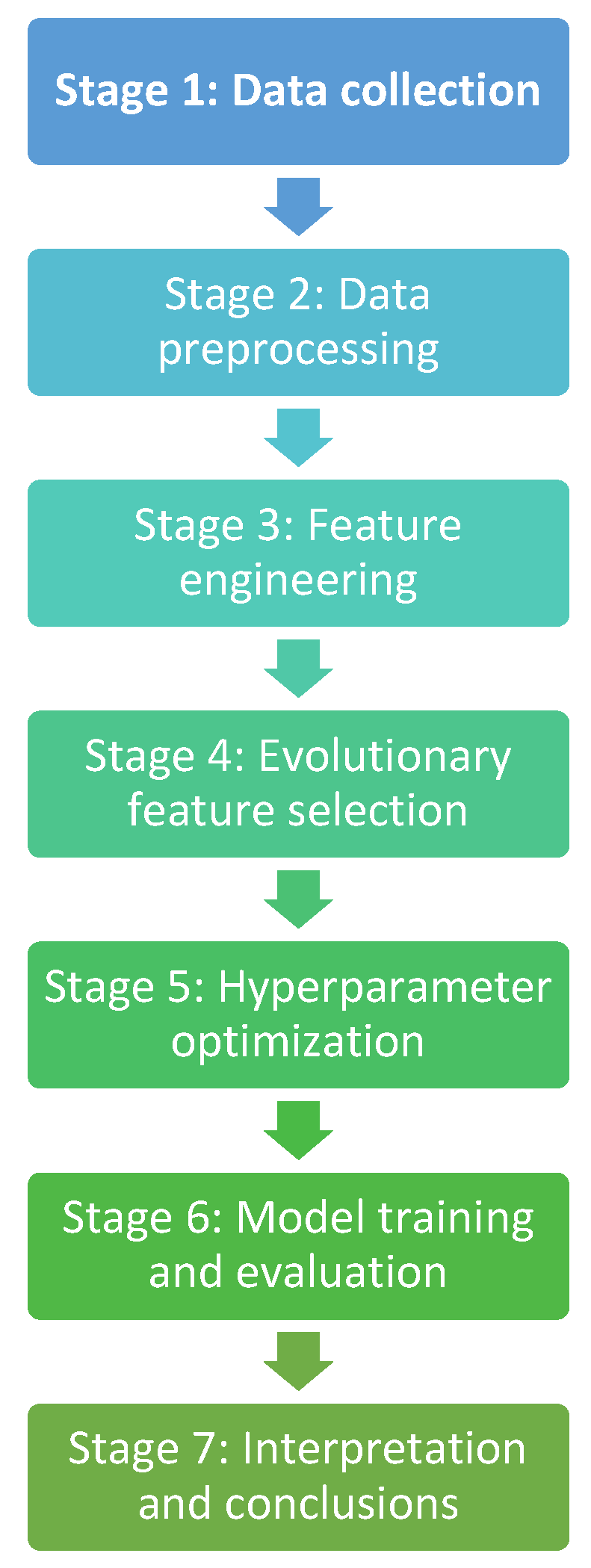
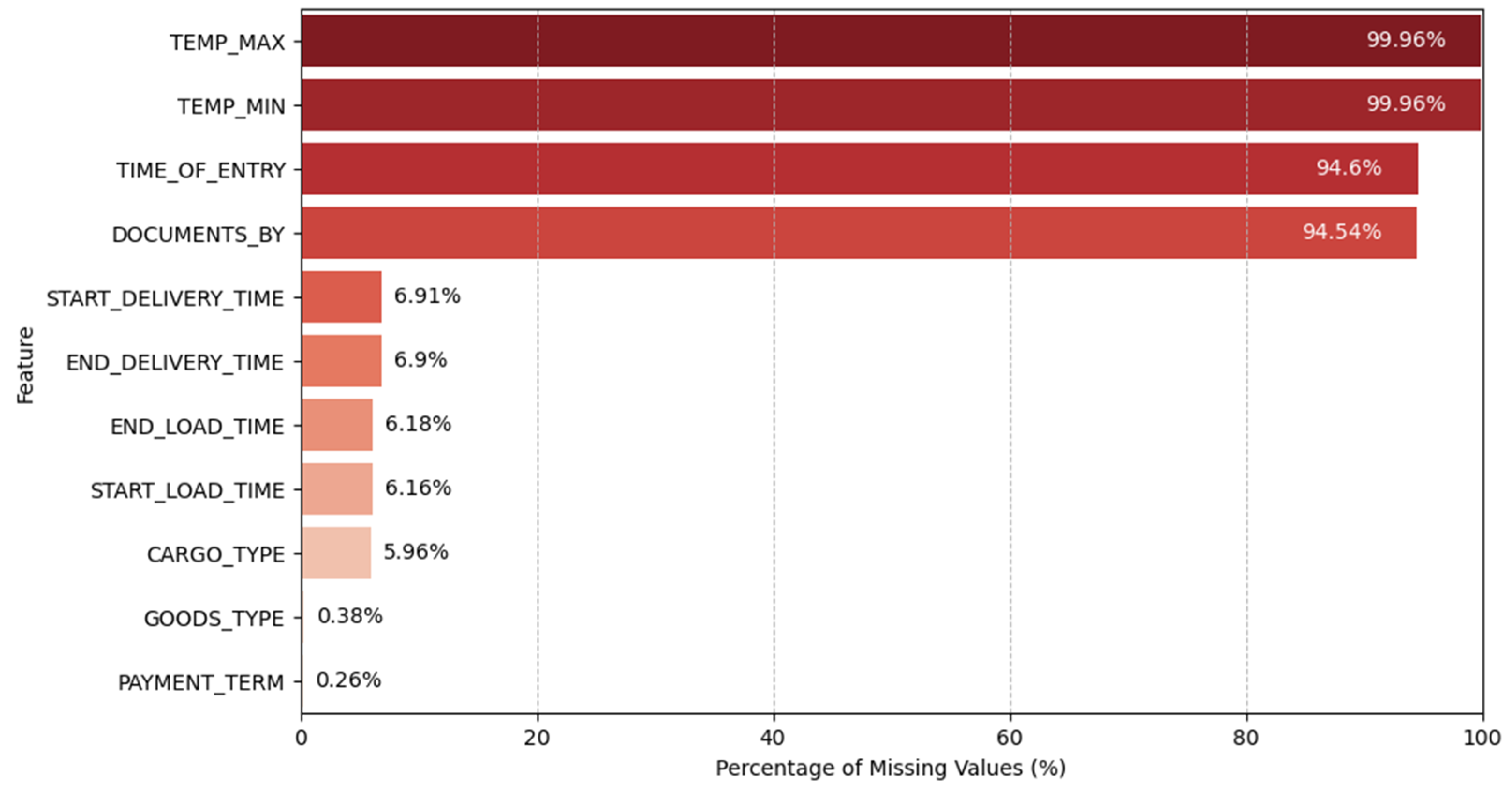

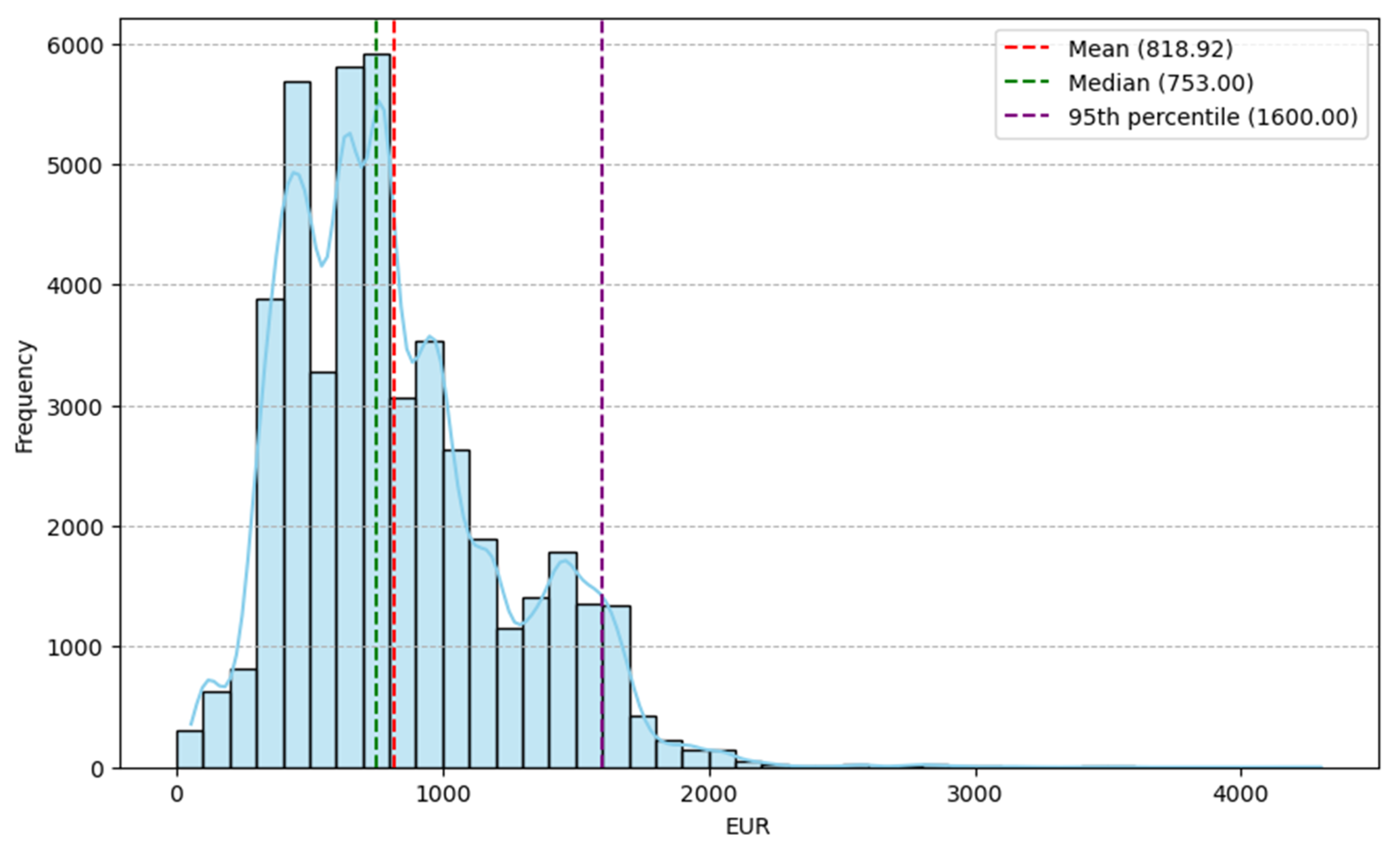

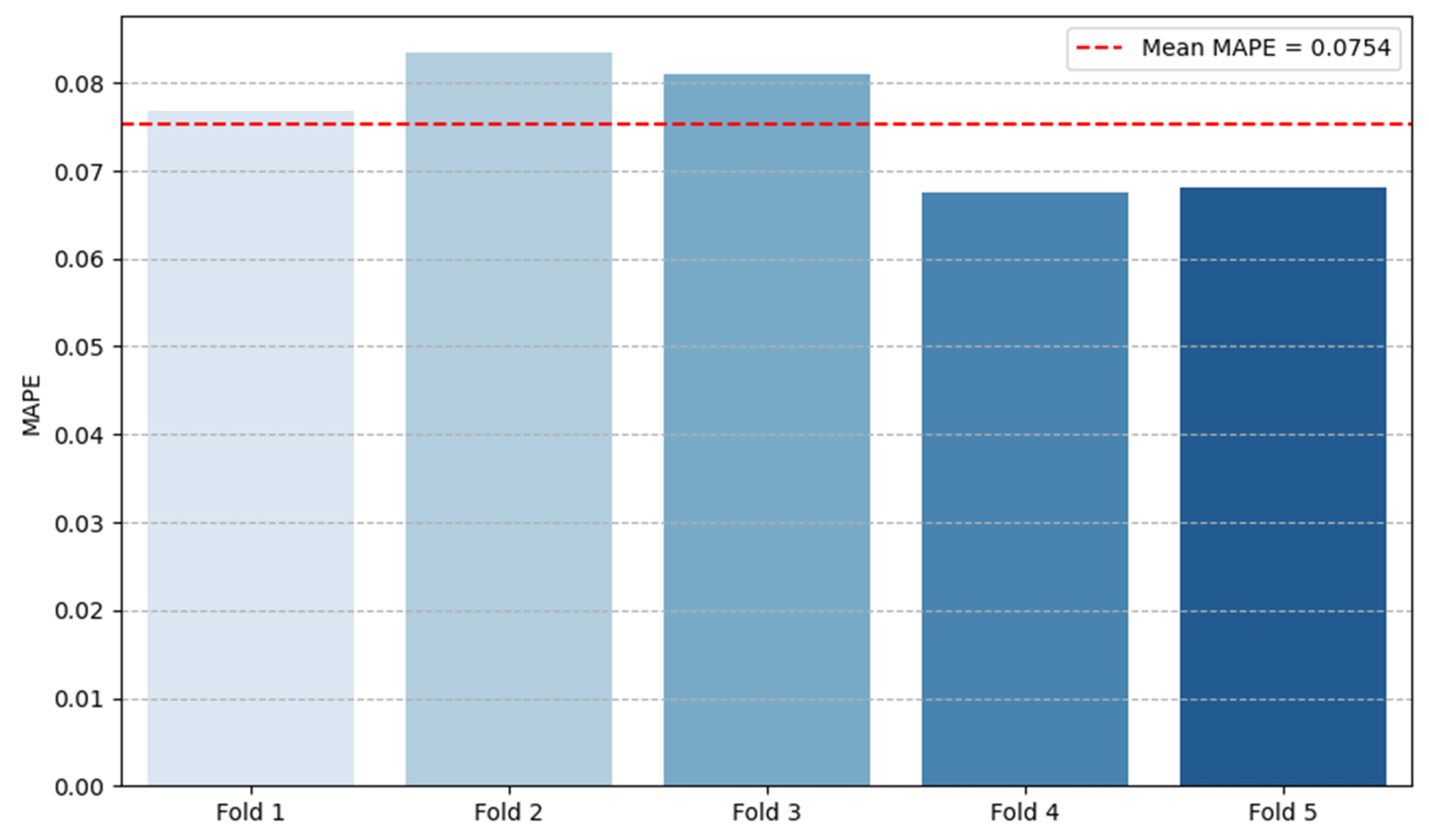
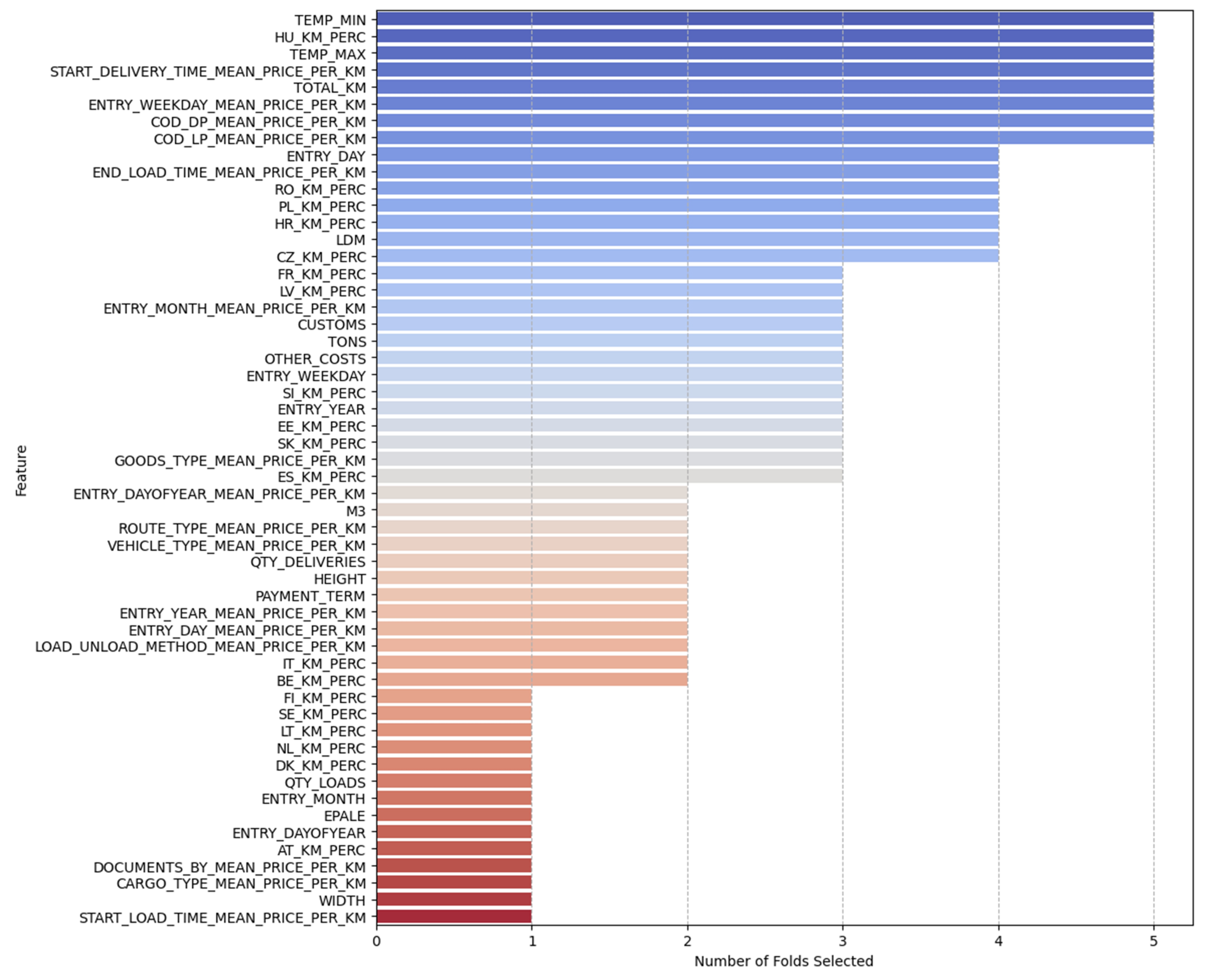

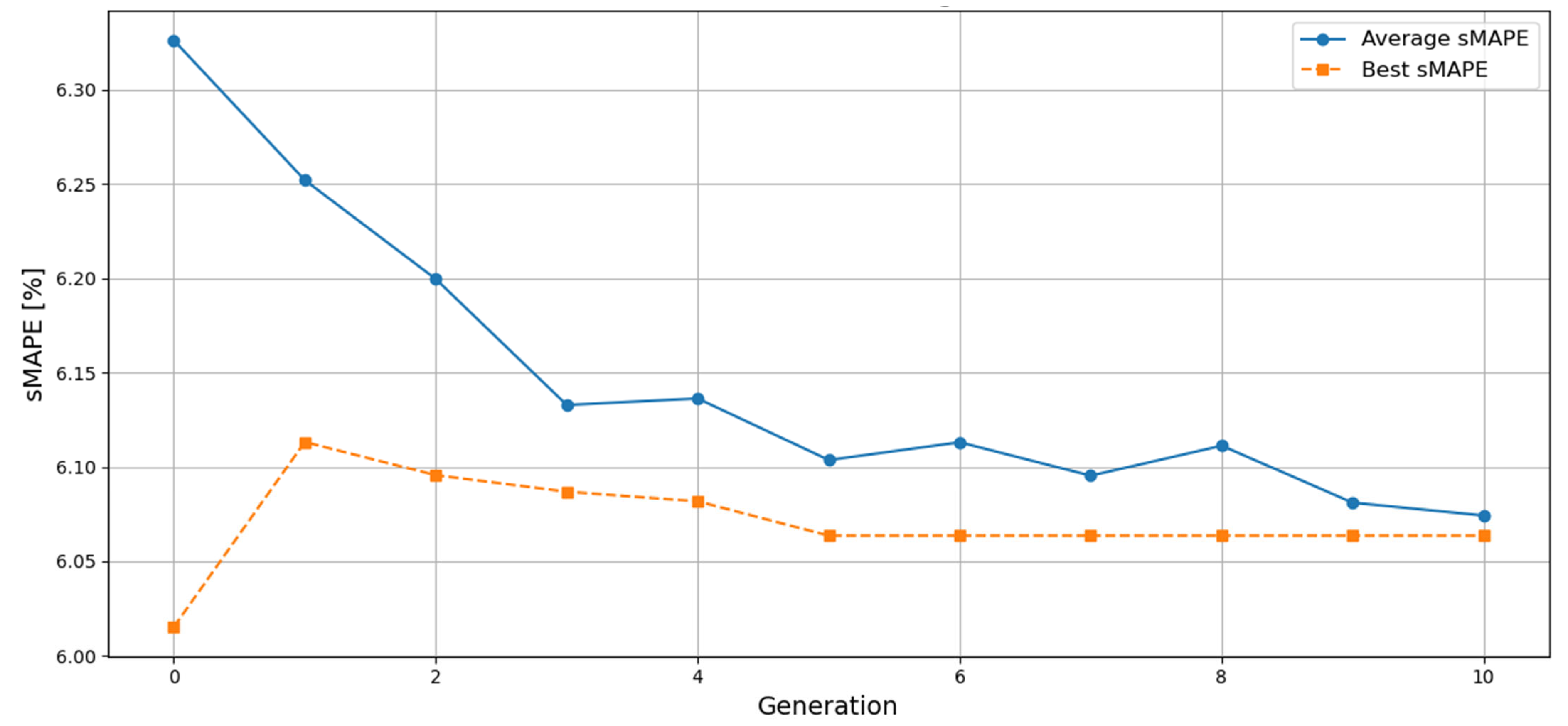
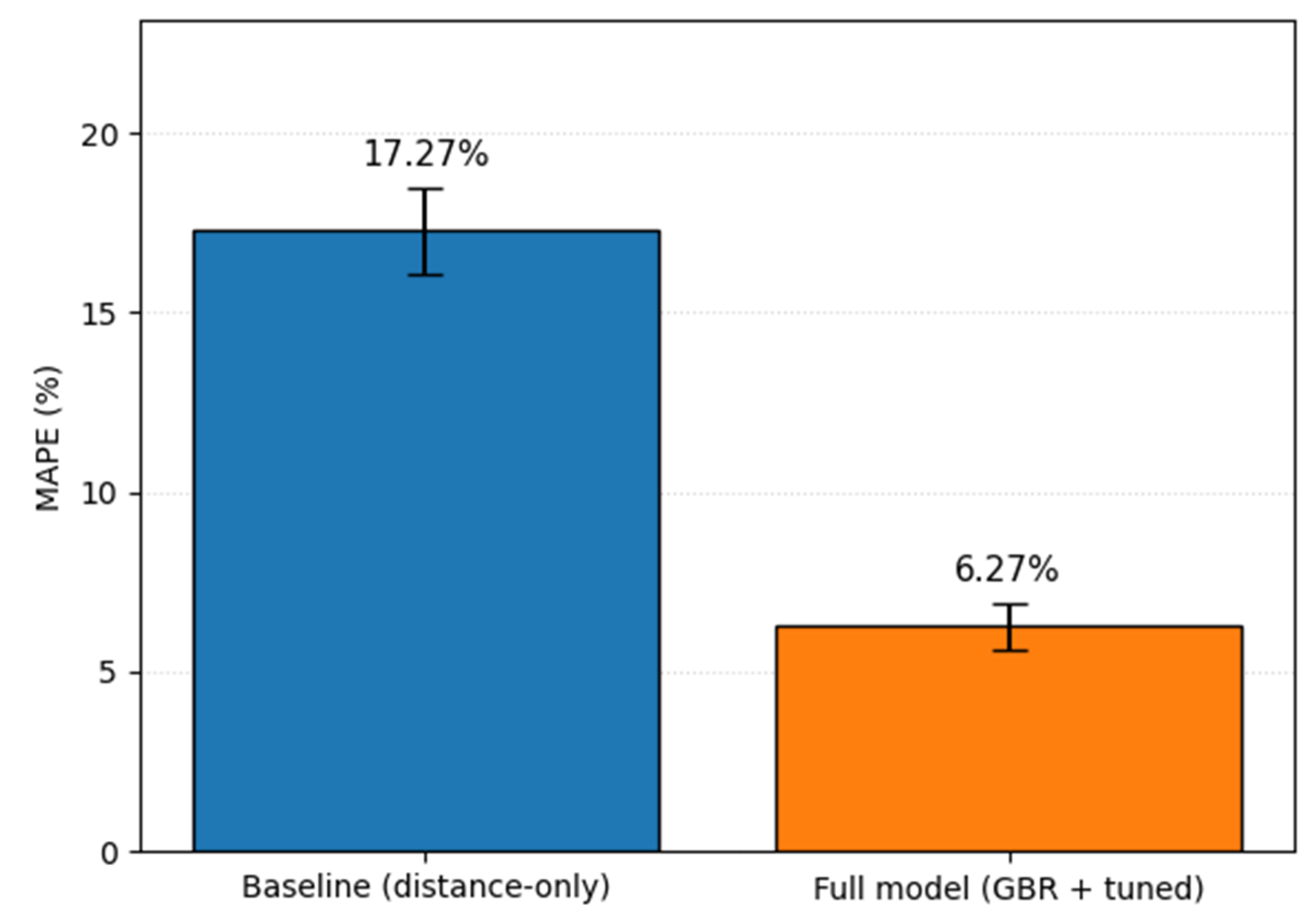
| Type | Feature | Explanation | Reference |
|---|---|---|---|
| Internal | Labour | Higher wages and benefits increase operational costs. | Levinson et al. [18], Nash and Sinsom [19] |
| Vehicle type and capacity utilization | Improved capacity usage reduces the cost per unit, whereas trucks that are under-utilized raise expenses. | ATRI [20], Abate [21], Galkin et al. [22], Samchuk et al. [23] | |
| Distance and route efficiency | Longer distances and difficult routes increase time and fuel consumption, raising rates. | Zgonc et al. [24], Álvarez et al. [25] | |
| Type of cargo | Perishables, hazardous materials, or high-value goods require special handling, leading to higher freight charges. | Mommens et al. [26,27] | |
| Delivery speed and reliability | Express deliveries cost more due to prioritization and tighter scheduling. | De Jong [28], Sert et al. [29] | |
| Backhaul opportunities | Availability of return cargo (backhaul) affects rate optimization. | Stoop et al. [30], Guerrero et al. [31] | |
| External | Fuel prices | Rising fuel costs elevate transportation expenses, frequently transferred to consumers via fuel surcharges. | Gohari et al. [32], Winebrake [33] |
| Regulatory and legal factors | Tolls, taxes, emissions regulations, and labour laws increase freight costs. | Santos [34], Carlan et al. [35] | |
| Market demand and supply (capacity) | Freight rates rise during peak seasons or when trucks are in short supply. | Friedt and Wilson [36] | |
| Seasonality and weather conditions | Adverse weather and seasonal peaks (e.g., holidays, harvests) impact availability and cost. | Raju et al. [37], Chu [38] | |
| Geopolitical events and disruptions | Unforeseen events can severely constrain capacity or increase risks (e.g., COVID-19). | Ahmady et al. [39], Monge et al. [40], Marcucci et al. [41] |
| Year | Research Works | Domain/Topic | ML Models Used | Key Findings | Specifics |
|---|---|---|---|---|---|
| 2025 | Kim et al. [46] | Container Freight Rate Prediction | Decision tree, Random Forest, LSTM, Prophet | Assesses the predictive capabilities of four models in estimating container freight rates. The decision tree demonstrated greater relative precision. | Concentrates on predicting container shipping costs for informed decision-making in the maritime sector. |
| 2024 | Guo et al. [47] | Iron Ore Shipping Freight Rate Prediction | Reinforcement learning (Q-learning), Quantile Regression Neural Network (QRNN), GARCH, Extreme Learning Machine (ELM), Long Short-Term Memory (LSTM), STL (Seasonal–Trend decomposition using Loess) | Suggests a “decomposition–integration” approach for forecasting intervals of iron ore shipping freight rates. Integrates decomposition techniques with reinforcement learning to dynamically adjust the weighting of prediction outputs, enhancing precision and dependability for fluctuating freight rate data. | Focuses on handling the volatility and non-stationarity of iron ore shipping freight rate data for investment decisions and risk management. |
| 2024 | Kjeldsberg and Haque Munim [48] | Platform Supply Vessel (PSV) Freight Market Prediction | Automated Machine Learning (AutoML) frameworks, Eureqa Generalized Additive Model, eXtreme Gradient Boosted Trees Regressor, Ridge Regressor with Forecast Distance Modelling | Explores AutoML for forecasting PSV time charter freight rates. Identifies 43 relevant influencing factors and tests 79 complex ML models. | Focuses on predicting PSV time charter freight rates for offshore oil and gas industry. |
| 2023 | Saeed et al. [49] | Container Freight Rate Forecasting | Prophet, Natural Language Processing (NLP) with zero-shot learning | Applies Prophet forecasting by incorporating categorized disruptive events (extracted using ML and NLP) to improve accuracy on six major container routes. | Concentrates on the impact of major disruptive incidents on container freight rates and how to integrate them into predictive models. |
| 2024 | Wang et al. [50] | Baltic Dry Index (BDI) Forecasting | Prophet model | Investigates BDI forecasting by considering the impact of multi-dimensional significant events using the Prophet model. Establishes a “significant event database”. | Aims to support shipping market stakeholders in understanding risks and making informed decisions regarding international dry bulk shipping rates. |
| 2025 | Lechtenberg and Hellingrath [51] | Implementation of ML in Road Freight Transport Operational Planning | Not specific models but discusses ML implementation in general | Provides direction for professionals to recognize and execute machine learning applications for operational planning activities in road freight transport, tackling issues such as limited ML expertise. | Concentrates on connecting the divide between theoretical ML capabilities and real-world implementation in road freight operational planning. |
| 2021 | Budak and Sarvari [52] | Profit Margin Prediction in Sustainable Road Freight Transportation | ML (general), hybrid ML methodologies | Predicts profit margin for freight trucking in sustainable road transportation. Determines variables affecting profit margin and provides a decision support model for managers. | Aims to create sustainable road freight transport strategies and assist managers in making decisions concerning profit margins within this framework. |
| 2024 | Yin et al. [53] | ML Applications in Freight and Logistics Research | Extreme Learning Machine (ELM), Convolutional Neural Network (CNN) | Novel real-time multi-step forecasting system with 3-stage data preprocessing; superior for streaming data with concept drift. | Primarily focuses on the China Containerized Freight Index (CCFI) as a crucial indicator for container freight rates and the global shipping market |
| 2022 | El Ouadi ate al. [54] | Urban Logistics, Freight Consolidation | K-means (clustering), Support Vector Machine (SVM) (forecasting) | Sequential ML approach (clustering + forecasting) for urban land splitting; K-means for clustering, SVM most efficient for forecasting. | The study directly addresses urban logistics challenges, such as freight consolidation and zoning. |
| 2022 | Johnson et al. [55] | Freight Network Vulnerability | Gradient Boosting Machines | Simulation-based approach using partial dependence plots (from GBM) to infer spatial vulnerabilities to area-spanning disruptions. | Examines the US multimodal freight transportation network and its susceptibility to various disruptions, such as extreme weather events |
| Column Name | Data Type |
|---|---|
| AT_KM, BE_KM, CZ_KM, DE_KM, DK_KM, EE_KM, ES_KM, FI_KM, HR_KM, FR_KM, HU_KM, IT_KM, LT_KM, LV_KM, NL_KM, PL_KM, RO_KM, SE_KM, SI_KM, SK_KM | float64 |
| COD_LP, COD_DP, ROUTE_TYPE, START_LOAD_TIME, END_LOAD_TIME, START_DELIVERY_TIME, END_DELIVERY_TIME, VEHICLE_TYPE, BODY_TYPE, LOAD_UNLOAD_METHOD, GOODS_TYPE, CARGO_TYPE, DOCUMENTS_BY | object |
| START_LOAD_DATE, END_LOAD_DATE, START_DELIVERY_DATE, END_DELIVERY_DATE, TIME_OF_ENTRY | datetime64 [ns] |
| EPALE, QTY_LOADS, QTY_DELIVERIES, CUSTOMS | int64 |
| TEMP_MIN, TEMP_MAX, EUR, LDM, M3, HEIGHT, WIDTH, TONS, OTHER_COSTS, PAYMENT_TERM | float64 |
| Original Feature(s) | Transformation Operation | Resulting Feature(s) |
|---|---|---|
| Kilometre columns (AT_KM to SK_KM) | Calculation of percentage share of total kilometres (TOTAL_KM) | Percentage columns (AT_KM_PERC to SK_KM_PERC) |
| TEMP_MIN | Missing value imputation with minimum observed value | Imputed TEMP_MIN |
| TEMP_MAX | Missing value imputation with maximum observed value | Imputed TEMP_MAX |
| PAYMENT_TERM | Missing value imputation with mean observed value | Imputed PAYMENT_TERM |
| Other features | Missing value imputation with mean observed value | Imputed features |
| Original Feature(s) | Aggregation Operation | Resulting Feature(s) |
|---|---|---|
| COD_LP | Mean PRICE_PER_KM per loading point | COD_LP_MEAN_PRICE_PER_KM |
| COD_DP | Mean PRICE_PER_KM per delivery point | COD_DP_MEAN_PRICE_PER_KM |
| ROUTE_TYPE | Mean PRICE_PER_KM per route type | ROUTE_TYPE_MEAN_PRICE_PER_KM |
| VEHICLE_TYPE | Mean PRICE_PER_KM per vehicle type | VEHICLE_TYPE_MEAN_PRICE_PER_KM |
| BODY_TYPE | Mean PRICE_PER_KM per body type | BODY_TYPE_MEAN_PRICE_PER_KM |
| LOAD_UNLOAD_METHOD | Mean PRICE_PER_KM per load/unload method | LOAD_UNLOAD_METHOD_MEAN_PRICE_PER_KM |
| GOODS_TYPE | Mean PRICE_PER_KM per goods type | GOODS_TYPE_MEAN_PRICE_PER_KM |
| CARGO_TYPE | Mean PRICE_PER_KM per cargo type | CARGO_TYPE_MEAN_PRICE_PER_KM |
| DOCUMENTS_BY | Mean PRICE_PER_KM per document delivery method | DOCUMENTS_BY_MEAN_PRICE_PER_KM |
| START_LOAD_TIME | Mean PRICE_PER_KM per rounded loading start hour | START_LOAD_TIME_MEAN_PRICE_PER_KM |
| END_LOAD_TIME | Mean PRICE_PER_KM per rounded loading end hour | END_LOAD_TIME_MEAN_PRICE_PER_KM |
| START_DELIVERY_TIME | Mean PRICE_PER_KM per rounded delivery start hour | START_DELIVERY_TIME_MEAN_PRICE_PER_KM |
| END_DELIVERY_TIME | Mean PRICE_PER_KM per rounded delivery end hour | END_DELIVERY_TIME_MEAN_PRICE_PER_KM |
| Curve | Start MAPE | End MAPE | Drop (pp) | Kendall τ | p (Kendall) | Mann–Whitney U | p (U-Test) |
|---|---|---|---|---|---|---|---|
| AVG | 0.07 | 0.06 | 0.30 | −0.78 | 0.00 | 9.00 | 0.05 |
| BEST | 0.06 | 0.06 | 0.07 | −0.58 | 0.02 | 6.00 | 0.33 |
Disclaimer/Publisher’s Note: The statements, opinions and data contained in all publications are solely those of the individual author(s) and contributor(s) and not of MDPI and/or the editor(s). MDPI and/or the editor(s) disclaim responsibility for any injury to people or property resulting from any ideas, methods, instructions or products referred to in the content. |
© 2025 by the authors. Licensee MDPI, Basel, Switzerland. This article is an open access article distributed under the terms and conditions of the Creative Commons Attribution (CC BY) license (https://creativecommons.org/licenses/by/4.0/).
Share and Cite
Budzyński, A.; Cieśla, M. Enhancing Road Freight Price Forecasting Using Gradient Boosting Ensemble Supervised Machine Learning Algorithm. Mathematics 2025, 13, 2964. https://doi.org/10.3390/math13182964
Budzyński A, Cieśla M. Enhancing Road Freight Price Forecasting Using Gradient Boosting Ensemble Supervised Machine Learning Algorithm. Mathematics. 2025; 13(18):2964. https://doi.org/10.3390/math13182964
Chicago/Turabian StyleBudzyński, Artur, and Maria Cieśla. 2025. "Enhancing Road Freight Price Forecasting Using Gradient Boosting Ensemble Supervised Machine Learning Algorithm" Mathematics 13, no. 18: 2964. https://doi.org/10.3390/math13182964
APA StyleBudzyński, A., & Cieśla, M. (2025). Enhancing Road Freight Price Forecasting Using Gradient Boosting Ensemble Supervised Machine Learning Algorithm. Mathematics, 13(18), 2964. https://doi.org/10.3390/math13182964







